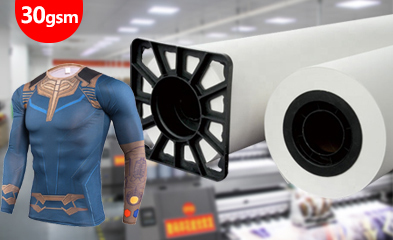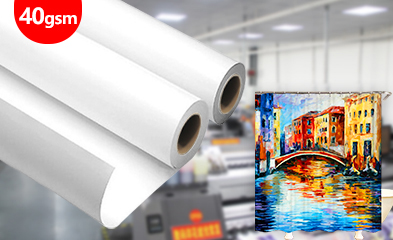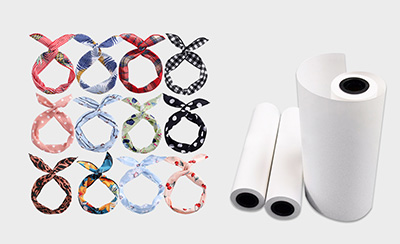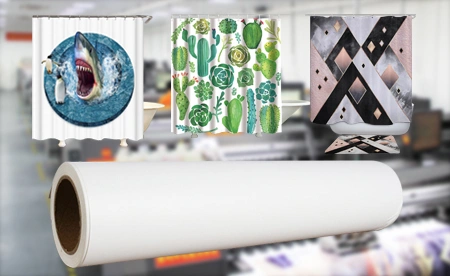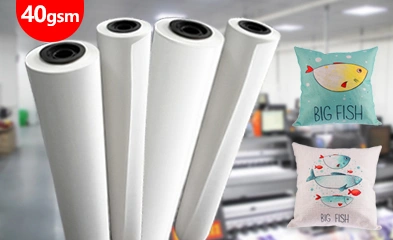HOT SALE
APPLICATION
Phone:+86-15215969856 E-Mail: 396838165@qq.com
Sublimation ink t-shirt printing is a super fun way to mix creativity and careful steps to make colorful, awesome clothes. This guide shows you the tools, supplies, and steps to get great results. Picking the right polyester fabrics and Sublimation Ink is key. So is setting up your design and using the Heat transfer machine correctly. Every part matters for a cool print. If you’re new or want to get better, these simple tips will help you make tough, neat t-shirts that look like a pro made them.
Essential Supplies for a Sublimation Ink T-Shirt Project
To make really cool sublimation ink t-shirts, grab the right stuff from the start. Good tools and materials make everything easier.
List of Materials You’ll Need
You need special Sublimation Ink, Sublimation Paper, and polyester fabrics. A Heat transfer machine is super important too. Get a Printer that works with Sublimation Ink. You’ll also need Sublimation Paper made for fabric. Pick polyester or poly-blend t-shirts. A Heat transfer machine is a must-have. Don’t use a regular oven—it’s not good for t-shirt sublimation. It might work for mugs or ceramics, though. Grab some Tissue paper (special heat-resistant paper), heat-resistant tape, and scissors for cutting your designs.
Choosing the Right Type of T-Shirt for Sublimation
The fabric you pick is a big deal. Heat makes Sublimation Ink stick to polyester fibers forever. Cotton doesn’t hold the ink well. It fades super fast. Go for 100% polyester t-shirts to get the best look. Blends with 65% polyester or more are okay too.
Selecting Quality Sublimation Ink and Paper
Safe, planet-friendly Sublimation Ink makes your projects look great and stay safe. It gives bold black colors after printing. Plus, it makes colors pop out bright. Changfa Digital, a solid company that makes Sublimation Paper, sells it in 40gsm to 100gsm weights. These work for all kinds of printing and give smooth, steady results.
Preparing Your Design for Sublimation
Setting up your design the right way is huge for making t-shirts that look professional. Good file prep, color choices, and sizing make sure the design sticks perfectly to the fabric.
Software Options for Creating or Editing Designs
Try programs like Adobe Illustrator, Photoshop, or CorelDRAW to make your designs. Free ones like GIMP or Canva are awesome too. You can draw cool pictures, fix images, or set up files with the right colors. Make sure your software works with CMYK color mode. It matches what the Printer does better than RGB mode.
Tips for Color Management and Image Resolution
Make your design at least 300 DPI so it looks super clear. Use CMYK color mode, not RGB, to get the right colors. Sublimation designs shine on white or light polyester shirts. Tweak the brightness or color strength if you need to. Print a small test first to see if the colors look good.
Mirroring and Sizing the Design Correctly
Flip your design side-to-side before you print it. Sublimation flips the image when it transfers. Check that the design fits the t-shirt size. Leave some space around the edges. Don’t put designs over seams, like near the collar or sides. They’re hard to press right. Measure from the collar, shoulders, and sides to keep the design in the middle.
Printing Your Design with Sublimation Ink
Getting your Printer ready gives you bright colors and clean prints. Knowing how your gear works saves materials and makes things turn out better.
Setting Up Your Sublimation Printer
Put Sublimation Ink that fits your Printer model into the machine. Most use cyan, magenta, yellow, and black (CY, MG, YL, BK). Keep the printhead clean. Do alignment checks to make prints sharp. Only use Sublimation Ink. Regular inkjet inks won’t stick to polyester.
Printer Settings for Optimal Results
Pick the best print quality, like “Photo” or “Best” mode, for clear, bright pictures. Turn off color fixes so your colors stay true. Choose “Photo Paper” or “Glossy” as the paper type. Sublimation Paper might not show up in the settings.
Loading and Printing on Sublimation Paper
Get Sublimation Paper that transfers well and dries fast. Load it so the coated side faces the Printer’s print area. Be gentle to avoid fingerprints or water. Those can mess up the print. Let the prints dry all the way before you touch them.
Heat Pressing the Design onto the T-Shirt
The Heat transfer machine locks your design into the fabric for good. You need to control heat, pressure, and time just right for awesome results.
Preparing the Heat Transfer Machine
Warm up your Heat transfer machine to 400°F (204°C). That’s the usual temperature for sublimation. Make sure the heat spreads evenly over the surface. Clean the press plates a lot. Dirt can mess up the transfer or leave spots on your t-shirt.
Temperature, Pressure, and Time Settings
Try starting with 400°F, medium-strong pressure, and 60 seconds of pressing. Settings change depending on the fabric and Sublimation Paper. Test temperatures from 380°F to 410°F. Try times between 45 and 75 seconds on scraps first. Find what works. Too little heat makes the design patchy. Too much heat can mess up the colors.
Aligning the Design on the Fabric
Place the design in the right spot on the t-shirt. Use heat-resistant tape to hold the Sublimation Paper still. Measure from the collar, shoulders, and bottom to keep it centered. Put Tissue paper (special heat-resistant paper, like butcher paper or parchment, not regular tissue) on both sides of the t-shirt. This stops ink from spreading where it shouldn’t.
Post-Pressing Steps and Quality Checks
Doing the right stuff after pressing keeps your t-shirt safe and shows the final design. These steps make your project a win.
Cooling Down and Removing Transfer Paper
Wait 10-15 seconds for the t-shirt to cool a bit before peeling off the Sublimation Paper. Some papers need peeling when hot, others when cool. Look at the paper’s instructions to do it right. Peel slowly so you don’t hurt the design.
Inspecting Print Quality and Color Accuracy
Check the design to make sure it transferred all the way with no mistakes. Look at the edges and tiny details to see if they’re okay. Compare the printed colors to your original design. Write down any color differences for next time. Keep the settings that worked well.
Washing Instructions to Preserve Print Longevity
Sublimated designs are really tough. They have a Sunproof Level 6 and Washproof Level 4-5 rating. Wash t-shirts in cold water with gentle soap. Don’t use bleach or fabric softeners. They can hurt polyester fibers. Flip the t-shirt inside out to keep the printed area safe when washing.
Common Mistakes to Avoid in Your First Project
Catching common goofs helps newbies save time and stuff. It also makes things less stressful. Knowing these mistakes gives you better results on your first try.
Inadequate Heat or Pressure Settings
Not enough heat or pressure makes the design look spotty or faded. Too much pressure can push the paper’s texture into the fabric. Test your Heat transfer machine with scraps first. Find the right settings before you start the real project.
Using Incompatible Fabrics or Inks
Regular inkjet inks don’t work for sublimation. Cotton fabrics won’t hold Sublimation Ink for long. Check the fabric’s polyester amount. Use Sublimation Ink and a Printer made for it. Mixed fabrics can make colors look uneven.
Poor Image Resolution or Incorrect Mirroring
Blurry images look bad when you make them bigger. Forgetting to flip the design makes text or pictures backward. Use high-quality images and check the flip before printing. Look at your design on the screen to spot problems early.
Recommended Tools and Brands for Beginners
Newbies should pick cheap tools so they don’t spend too much on fancy stuff. Good equipment makes starting simple and gives nice results.
Entry-Level Heat Transfer Machines Worth Considering
Get a Heat transfer machine with even heat, good temperature control, and pressure you can adjust. Clamshell designs are easy and not too pricey for beginners. Choose a press big enough for your biggest designs so it works for all projects.
Affordable Yet Reliable Sublimation Printers
Basic Printers from trusted brands do the job without extra stuff. Look for ones with separate ink cartridges for each color. That makes refilling easier. Focus on steady printing and good quality, not speed or paper size.
High-Quality Inks and Papers for Sharp Results
Great Sublimation Ink that matches your Printer model gives bright, long-lasting prints on polyester. It has wide color coverage and stays strong after washing (Level 4-5). Always pick Sublimation Ink that works with your Printer, like some Epson or Sawgrass models, for steady single-sheet or small-batch prints. Top Sublimation Paper handles widths from 61cm to 320cm. It prints quietly and makes sharp, clear designs every time.
Introducing Changfa Digital: A Trusted Partner in Sublimation Supplies
Changfa Digital is a pro at making Sublimation Paper. It’s been a reliable supplier for over 15 years. The company offers everything you need for sublimation printing.
Overview of Changfa Digital’s Product Offerings
Changfa Digital makes Sublimation Paper and does digital printing services. Its factory handles making base paper, coating it, cutting it, and packing it. They offer Sublimation Paper in 29gsm to 100gsm weights for all printing jobs. The factory has four coating lines and four cutting workshops with ten machines. They make 2- and 3-inch core rolls. They produce 3,000 tons a month. They ship 120 containers around the world every month.
Conclusion
Sublimation ink t-shirt printing is a blast and lets you mix creativity with skill. You can make bright, tough clothes that look like a pro made them. Pick awesome polyester fabrics and trusty Sublimation Ink. Get good at setting up designs, using the Printer, and pressing with the Heat transfer machine. Skip common mistakes and use solid tools from places like Changfa Digital. That makes things easier and builds your confidence. With practice and care, your first sublimation project can start a fun journey to making cool, lasting custom t-shirts.
FAQs
Q1: What type of fabric works best with Sublimation Ink?
A: Polyester fabrics are the best for sublimation printing. Sublimation Ink sticks to polyester fibers forever when heated. Use 100% polyester t-shirts for awesome results. Blends with 65% polyester or more are good too. Cotton or natural fibers don’t work well. The designs fade after washing.
Q2: Can I use a regular printer for sublimation printing?
A: Nope, regular inkjet printers can’t handle Sublimation Ink. You need a special sublimation Printer or a compatible inkjet model (like some Epson or Sawgrass printers) set up for Sublimation Ink. It has to work with Sublimation Paper and the heat transfer process.
Q3: How long does a sublimated t-shirt design last?
A: Sublimation designs on polyester last as long as the t-shirt. The Sublimation Ink bonds to the fibers for good. The designs stay bright if you wash in cold water and skip bleach. Unlike vinyl or screen printing, sublimation designs won’t peel or fade.



